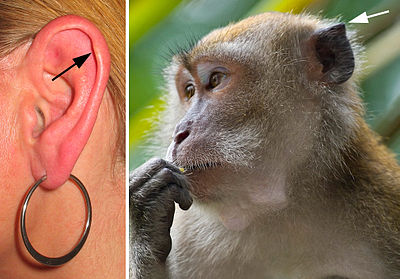Darwin's tubercle

Darwin's tubercle is a congenital ear condition which often presents as a thickening on the helix at the junction of the upper and middle thirds. The feature is present in approximately 10.4% of the population.[1] This acuminate nodule represents the point of the mammalian ear.
This atavistic feature is so called because its description was first published by Charles Darwin in the opening pages of The Descent of Man, as evidence of a vestigial feature indicating common ancestry among primates. However Darwin himself named it the Woolnerian tip, after Thomas Woolner, a British sculptor who had depicted it in one of his sculptures and had first theorised that it was an atavistic feature.
The gene for Darwin's tubercle is inherited in an autosomal dominant pattern, and has incomplete penetrance, meaning that those who possess the gene will not necessarily possess the ear tubercle.[2]
See Also
References
- ^ "An anthropometric study of the ear in an adult population", International Journal of Anthropology, Issue Volume 1, Number 2 / June, 1986 ISSN 0393-9383
- ^ "The old curiosity shop" - New Scientist issue number 2656; 17th May 2008; http://www.newscientist.com/channel/being-human/mg19826562.100-vestigial-organs-remnants-of-evolution.html
External links
- . GPnotebook https://www.gpnotebook.co.uk/simplepage.cfm?ID=832176200.
{{cite web}}: Missing or empty|title=(help)
